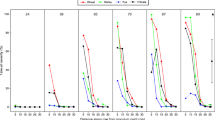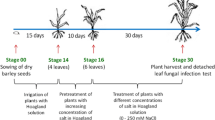Abstract
The temperature requirements of three single cystosorus strains of Polymyxa sp. from India were studied at 15–18, 19–22, 23–26 and 27–30 °C (night-day temperature), and compared with the temperature requirements of three strains of P. graminis from Belgium, Canada and France and two strains of P. betae from Belgium and Turkey. Sorghum was used as the host-plant for the Indian strains; the strains of P. graminis and P. betae from temperate areas were cultivated on barley and sugar beet, respectively. The cystosori germination and the development of plasmodia, zoosporangia and cystosori of Polymyxa sp. from India were optimal at 27–30 °C. Infection progression was slower at 23–26 °C than at 27–30 °C. At 19–22 °C, infection was insignificant. No infection occurred below 19 °C. In contrast, the infection of barley with P. graminis strains from temperate areas was optimal at 15–18 °C, but at 19–22 °C the progression appeared inconsistent and infection stayed low. Above 22 °C, infection was insignificant. P. betae strains showed consistent infection in the range of 15–18 °C to 27–30 °C. Plasmodia formation and cystosori detection of the Belgian strain were slightly advanced at 23–26 °C compared to 19–22 °C but clearly restrained at 27–30 °C. Fungus development of the P. betae strain from Turkey was almost as high at 27–30 °C as at the lower temperatures. These results strengthen the case for distinguishing between Polymyxa sp. from India and P. graminis or P. betae from temperate areas.
Similar content being viewed by others
References
Adams MJ (1990) Epidemiology of fungally-transmitted viruses. Soil Use and Management 6: 184-189
Adams MJ, Swaby AG and Macfarlane I (1986) The susceptibility of barley cultivars to barley yellow mosaic virus (BaYMV) and its fungal vector, Polymyxa graminis. Annals of Applied Biology 109: 561-572
Barr DJS (1979) Morphology and host range of Polymyxa graminis, Polymyxa betaeand Ligniera pilorumfrom Ontario and some other areas. Canadian Journal of Plant Pathology 1: 85-94
Blunt SJ, Asher MJC and Gilligan CA (1991) Infection of sugar beet by Polymyxa betaein relation to soil temperature. Plant Pathology 40: 257-267
de Heij A (1991) The influence of water and temperature on the multiplication of Polymyxa betae, vector of beet necrotic yellow vein virus. In: Beemster ABR, Bollen GJ, Gerlagh M, Ruissen MA, Schippers B and Tempel A (eds) Developments in agricultural and managed-forest ecology: biotic interactions and soil-borne diseases - Proceedings of the first conference of the European Foundation for Plant Pathology (pp. 83-90). Elsevier Science Publishers, Amsterdam, The Netherlands
Delfosse P, Devi PS, Reddy AS, Risopoulos J, Doucet D, Legrève A, Maraite H and Reddy DVR (1996) Epidemiology of Indian peanut clump virus transmitted by Polymyxasp. In: Sherwood JL and Rush CM (eds) Proceedings of the third symposium of the International Working Group on Plant Viruses with Fungal Vectors, West Park Conference Centre, Dundee, Scotland, August 6-7, 1996 (pp. 141-144). American Society of Sugar Beet Technologists, Denver, USA
Goffart JP and Maraite H (1991) Facteurs édaphiques et phytotechniques affectant le potentiel infectieux de Polymyxa betaeKeskin en Belgique. Parasitica 47: 165-192
Goffart JP and Maraite H (1992) Influence de la température sur Polymyxa betaeKeskin et le beet necrotic yellow vein virus (BNYVV). Mededelingen van de Faculteit Landbouwwetenschappen Rijksuniversiteit Gent 57/2a: 287-293
HajiTinggal S and Webster J (1981) Technique for single spore infection by Plasmodiophora brassicae. Transactions of the British Mycological Society 76: 187-190
Ivanovic M (1984) Polymyxa betaeKesk. as a parasite of sugar beet and vector of BNYVV. PhD Thesis, Faculty of Agriculture, University of Belgrade, Yugoslavia
Jones DR, Ingram DS and Dixon GR (1982) Characterization of isolates derived from single resting spores of Plasmodiophora brassicaeand studies of their interaction. Plant Pathology 31: 239-246
Keskin B (1964) Polymyxa betaen. sp., ein Parasit in den Wurzeln von Beta vulgarisTournefort, besonders während der Jugendentwicklung der Zuckerrübe. Archiv für Mikrobiologie 49: 348-374
Ledingham GA (1939) Studies on Polymyxa graminis, n. gen. n. sp., a plasmodiophoraceous root parasite of wheat. Canadian Journal of Research C 17: 38-51
Legrève A, Vanpee B, Risopoulos J, Ward E and Maraite H (1996) Characterization of Polymyxasp. associated with the transmission of Indian peanut clump virus. In: Sherwood JL and Rush CM (eds) Proceedings of the third symposium of the International Working Group on Plant Viruses with Fungal Vectors-West Park Conference Centre, Dundee, Scotland, August 6-7, 1996 (pp. 157-160). American Society of Sugar Beet Technologists, Denver, USA
Maraite H (1991) Transmission of viruses by soil fungi. In: Beemster ABR, Bollen GJ, Gerlagh M, Ruissen MA, Schippers B and Tempel A (eds) Developments in agricultural andmanagedforest ecology: biotic interactions and soil-borne diseases - Proceedings of the first conference of the European Foundation for Plant Pathology (pp. 67-82). Elsevier Science Publishers, Amsterdam, The Netherlands
Maraite H, Goffart JP and Bastin V (1988) Development of a quantitative method for assessment of Polymyxa graminisLed. inoculum potential in soils. In: Cavalloro R and Sunderland KD (eds) Integrated crop protection in cereals - Proceedings of a Meeting of the EC Experts' Group, Littlehampton, 25-27 November 1986 (pp. 259-266). Balkema, Rotterdam, The Netherlands
Nolt BL and Reddy DVR (1985) First report of Polymyxa graminisin India. Plant Disease 69: 542
Ratna AS, Rao AS, Reddy AS, Nolt BL, Reddy DVR, Vijayalakshmi M and McDonald D (1991) Studies on transmission of Indian peanut clump virus disease by Polymyxa graminis. Annals of Applied Biology 118: 71-78
Reddy DVR, Nolt BL, Hobbs HA, Reddy AS, Rajeshwari R, Rao AS, Reddy DDR and McDonald D (1988) Clump virus in India: isolates, host range, transmission and management. In: Cooper JI and Asher MJC (eds) Developments in Applied Biology II. Viruses with fungal vectors (pp. 239-246). Association of Applied Biologists, Wellesbourne, United Kingdom
Reddy DVR, Rajeshwari R, Iizuka N, Lesemann DE, Nolt BL and Goto T (1983) The occurrence of Indian peanut clump, a soil-borne virus disease of groundnuts (Arachis hypogaea) in India. Annals of Applied Biology 102: 305-310
Slykhuis JT and Barr DJS (1978) Confirmation of Polymyxa graminisas a vector of wheat spindle streak mosaic virus. Phytopathology 68: 639-643
Somé A, Manzanares MJ, Laurens F, Baron F, Thomas G and Rouxel F (1996) Variation for virulence on Brassica napusL. amongst Plasmodiophora brassicaecollections from France and derived singles-pore isolates. Plant Pathology 45: 432-439
Thouvenel JC, Dollet M and Fauquet C (1976) Some properties of peanut clump, a newly discovered virus. Annals of Applied Biology 84: 311-320
Thouvenel JC and Fauquet C (1980) Polymyxa graminison new Sorghumspecies in Africa. Plant Disease 64: 957-958
Thouvenel JC and Fauquet C (1981) Further properties of peanut clump virus and studies on its natural transmission. Annals of Applied Biology 97: 99-107
Ward E and Adams MJ (1996) Molecular studies of variation amongst isolates of Polymyxa graminisand Polymyxa betae. In: Sherwood JL and Rush CM (eds) Proceedings of the third symposium of the International Working Group on Plant Viruses with Fungal Vectors-West Park Conference Centre, Dundee, Scotland, August 6-7, 1996 (pp. 93-96). American Society of Sugar Beet Technologists, Denver, USA
Author information
Authors and Affiliations
Rights and permissions
About this article
Cite this article
Legrève, A., Delfosse, P., Vanpee, B. et al. Differences in temperature requirements between Polymyxa sp. of Indian origin and Polymyxa graminis and Polymyxa betae from temperate areas. European Journal of Plant Pathology 104, 195–205 (1998). https://doi.org/10.1023/A:1008612903927
Issue Date:
DOI: https://doi.org/10.1023/A:1008612903927




